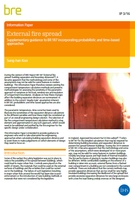External fire spread, Supplementary guidance to BR 187 incorporating probabilistic and time-based approaches
BRE is the UK’s leading centre of expertise on the built environment, construction, energy use in buildings, fire prevention and control, and risk management.
External fire spread - Supplementary guidance to BR 187 incorporating probabilistic and time-based approaches was published by BRE on 31 May 2016. It was written by Dr Sung-han Koo.
The Information Paper was prepared following revision of BR 187 External fire spread: building separation and boundary distances, when it became apparent the methodology and some of the assumptions used may not be valid for some features in modern buildings. It is intended to provide guidance to engineers who wish to take alternative fire engineering approaches when calculating building separation distance and to help them make judgements about which elements of the design to focus on.
The Paper reviews existing fire compartment temperature calculation methods and presents methodologies for assessing the sensitivity of the parametric approach to variations in fire load, window size and insulation of compartment boundaries. Analyses of how these changes affect building separation distances are summarised.
In addition to the steady state assumption in BR 187, probabilistic and time-based approaches are also considered.
The contents of the paper are:
- Introduction.
- Fire models and compartment temperature calculation methods.
- Methods for calculating compartment temperatures.
- Comparison of fire compartment temperature calculation methods.
- Probabilistic and time-based methodologies.
- Conclusions.
- References.
See also: External fire spread: building separation and boundary distances (BR 187).
[edit] FRelated articles on Designing Buildings Wiki
- Automatic fire detection and alarm systems, an introductory guide to components and systems BR 510.
- BS 8414-2: Fire performance of external cladding systems.
- Building Research Establishment.
- Drenchers.
- External fire spread: building separation and boundary distances (BR 187).
- Fire.
- Fire and rescue service.
- Fire compartmentation.
- Fire dampers.
- Fire detection and alarm system.
- Fire performance of external thermal insulation for walls of multistorey buildings, third edition (BR 135).
- Fire protection engineering.
- Fire safety design.
- Fire spread.
- Joint fire code.
- The Regulatory Reform (Fire Safety) Order 2005.
- Understanding the factors affecting flashover of a fire in modern buildings.
- Wet riser.
Quick links
[edit] Legislation and standards
Fire Safety (England) Regulations 2022
Regulatory Reform (Fire Safety) Order 2005
Secondary legislation linked to the Building Safety Act
Building safety in Northern Ireland
[edit] Dutyholders and competencies
BSI Built Environment Competence Standards
Competence standards (PAS 8671, 8672, 8673)
Industry Competence Steering Group
[edit] Regulators
National Regulator of Construction Products
[edit] Fire safety
Independent Grenfell Tower Inquiry
[edit] Other pages
Building Safety Wiki is brought to you courtesy of:







Comments
Good description.